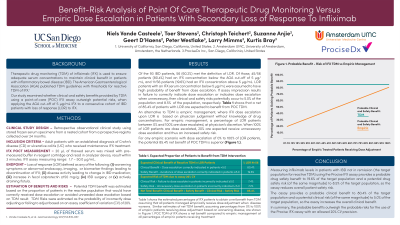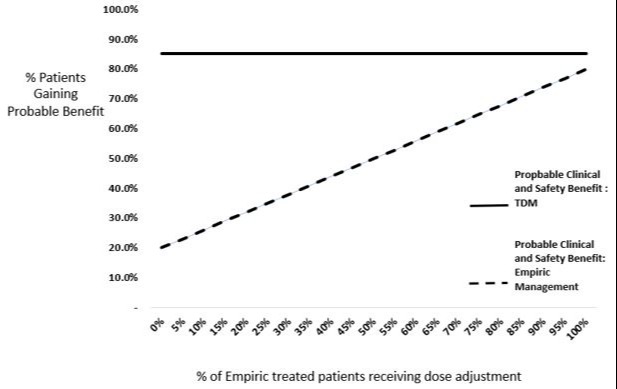Monday Poster Session
Category: IBD
P2221 - Benefit-Risk Analysis of Point of Care Therapeutic Drug Monitoring vs Empiric Dose Escalation in Patients with Secondary Loss of Response to Infliximab
Monday, October 23, 2023
10:30 AM - 4:15 PM PT
Location: Exhibit Hall

Has Audio
- NV
Niels Vande Casteele, PharmD, PhD
University of California San Diego
La Jolla, CA
Presenting Author(s)
Niels Vande Casteele, PharmD, PhD1, Toer Stevens, MD, PhD2, Christoph Teichert, MD2, Suzanne I.. Anjie, MD2, Geert D'Haens, MD, PhD2, Peter Westlake, MBA3, Larry Mimms, PhD3, Kurtis Bray, PhD3
1University of California San Diego, La Jolla, CA; 2Amsterdam University Medical Center, Amsterdam, Noord-Holland, Netherlands; 3ProciseDx Inc., San Diego, CA
Introduction: Therapeutic drug monitoring (TDM) of infliximab (IFX) is used to ensure adequate serum concentrations to maintain clinical benefit in patients with inflammatory bowel disease (IBD). The American Gastroenterological Association (AGA) published TDM guidelines with thresholds for reactive TDM of IFX. The current study examined whether clinical and safety benefits provided by TDM using a point-of-care (POC) IFX assay outweigh potential risks, when applying the AGA threshold of 5 μg/mL IFX to a consecutive cohort of IBD patients with loss of response (LOR) to IFX.
Methods: A retrospective study was conducted with serum from a nested cohort of IBD patients receiving maintenance IFX from a registry at Amsterdam UMC, Netherlands. The endpoint of LOR was defined as a change in IBD medication due to disease activity, or worsening of IBD seen by endoscopy or imaging, or elevated fecal calprotectin. Serum concentrations of IFX were measured with a POC test producing quantitative results within 3 minutes (ProciseDx Inc., San Diego, CA).
Results: Of the 93 IBD patients, 56 (60.2%) met the definition of LOR. Of those, 45/56 patients (80.4%) had an IFX concentration below the AGA cut-off of 5 μg/mL, and 11/56 patients (19.6%) had an IFX concentration above 5 μg/mL. LOR patients with an IFX serum concentration below 5 μg/mL were assumed to have high probability of benefit from dose escalation. If assay imprecision results in failure to correctly indicate dose escalation or indicates dose escalation when unnecessary, then clinical and safety risks occur. Table 1 shows that a net of 85.4% of patients with LOR are expected to benefit from POC TDM.
An alternative to TDM is empiric management, where IFX dose escalation upon LOR is based on physician judgement without drug concentrations. For empiric management, a percentage of LOR patients between 0% and 100% are dose escalated, at physician’s discretion. When 100% of LOR patients are dose escalated, 20% are expected receive unnecessary dose escalation and thus an increased safety risk. For any empiric scenario with dose escalation of 0% to 100% of LOR patients, the potential 85.4% net benefit of POC TDM is superior to empiric management (Figure 1.).
Discussion: The expected benefits provided by reactive POC TDM outweigh the expected risks, and a benefit-risk analysis demonstrates that reactive TDM is numerically superior to empiric management in IFX patients experiencing LOR.

Disclosures:
Niels Vande Casteele, PharmD, PhD1, Toer Stevens, MD, PhD2, Christoph Teichert, MD2, Suzanne I.. Anjie, MD2, Geert D'Haens, MD, PhD2, Peter Westlake, MBA3, Larry Mimms, PhD3, Kurtis Bray, PhD3. P2221 - Benefit-Risk Analysis of Point of Care Therapeutic Drug Monitoring vs Empiric Dose Escalation in Patients with Secondary Loss of Response to Infliximab, ACG 2023 Annual Scientific Meeting Abstracts. Vancouver, BC, Canada: American College of Gastroenterology.
1University of California San Diego, La Jolla, CA; 2Amsterdam University Medical Center, Amsterdam, Noord-Holland, Netherlands; 3ProciseDx Inc., San Diego, CA
Introduction: Therapeutic drug monitoring (TDM) of infliximab (IFX) is used to ensure adequate serum concentrations to maintain clinical benefit in patients with inflammatory bowel disease (IBD). The American Gastroenterological Association (AGA) published TDM guidelines with thresholds for reactive TDM of IFX. The current study examined whether clinical and safety benefits provided by TDM using a point-of-care (POC) IFX assay outweigh potential risks, when applying the AGA threshold of 5 μg/mL IFX to a consecutive cohort of IBD patients with loss of response (LOR) to IFX.
Methods: A retrospective study was conducted with serum from a nested cohort of IBD patients receiving maintenance IFX from a registry at Amsterdam UMC, Netherlands. The endpoint of LOR was defined as a change in IBD medication due to disease activity, or worsening of IBD seen by endoscopy or imaging, or elevated fecal calprotectin. Serum concentrations of IFX were measured with a POC test producing quantitative results within 3 minutes (ProciseDx Inc., San Diego, CA).
Results: Of the 93 IBD patients, 56 (60.2%) met the definition of LOR. Of those, 45/56 patients (80.4%) had an IFX concentration below the AGA cut-off of 5 μg/mL, and 11/56 patients (19.6%) had an IFX concentration above 5 μg/mL. LOR patients with an IFX serum concentration below 5 μg/mL were assumed to have high probability of benefit from dose escalation. If assay imprecision results in failure to correctly indicate dose escalation or indicates dose escalation when unnecessary, then clinical and safety risks occur. Table 1 shows that a net of 85.4% of patients with LOR are expected to benefit from POC TDM.
An alternative to TDM is empiric management, where IFX dose escalation upon LOR is based on physician judgement without drug concentrations. For empiric management, a percentage of LOR patients between 0% and 100% are dose escalated, at physician’s discretion. When 100% of LOR patients are dose escalated, 20% are expected receive unnecessary dose escalation and thus an increased safety risk. For any empiric scenario with dose escalation of 0% to 100% of LOR patients, the potential 85.4% net benefit of POC TDM is superior to empiric management (Figure 1.).
Discussion: The expected benefits provided by reactive POC TDM outweigh the expected risks, and a benefit-risk analysis demonstrates that reactive TDM is numerically superior to empiric management in IFX patients experiencing LOR.

Figure: Figure 1. Probable benefit-risk of IFX TDM vs. empiric management
Disclosures:
Niels Vande Casteele: Pfizer – Consultant. ProciseDx – Consultant. Prometheus Biosciences – Consultant.
Toer Stevens indicated no relevant financial relationships.
Christoph Teichert indicated no relevant financial relationships.
Suzanne Anjie indicated no relevant financial relationships.
Geert D'Haens: AbbVie – Consultant, Speakers Bureau. Alimentiv – Consultant, Speakers Bureau. Boehringer Ingelheim – Consultant, Speakers Bureau. Cellitrion – Consultant, Speakers Bureau. Ferring – Consultant, Speakers Bureau. Galapagos – Consultant, Speakers Bureau. GlaxoSmithKline – Consultant, Speakers Bureau. Gossamerbio – Consultant, Speakers Bureau. Janssen – Consultant, Speakers Bureau. Lilly – Consultant, Speakers Bureau. MSD – Consultant, Speakers Bureau. Pfizer – Consultant, Speakers Bureau. Progenity – Consultant, Speakers Bureau. Prometheus Biosciences – Consultant, Speakers Bureau. Prometheus Laboratories – Consultant, Speakers Bureau. Takeda – Consultant, Speakers Bureau. Tillotts – Consultant, Speakers Bureau.
Peter Westlake: ProciseDx Inc. – Employee.
Larry Mimms: ProciseDx Inc. – Employee. ProciseDx Inc. – Employee.
Kurtis Bray: ProciseDx Inc. – Employee.
Niels Vande Casteele, PharmD, PhD1, Toer Stevens, MD, PhD2, Christoph Teichert, MD2, Suzanne I.. Anjie, MD2, Geert D'Haens, MD, PhD2, Peter Westlake, MBA3, Larry Mimms, PhD3, Kurtis Bray, PhD3. P2221 - Benefit-Risk Analysis of Point of Care Therapeutic Drug Monitoring vs Empiric Dose Escalation in Patients with Secondary Loss of Response to Infliximab, ACG 2023 Annual Scientific Meeting Abstracts. Vancouver, BC, Canada: American College of Gastroenterology.
